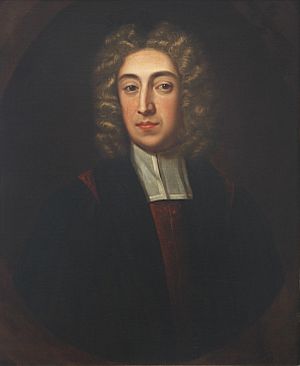Joseph Smith (academic) facts for kids
Joseph Smith (1670–1756) was an English churchman and a leader at The Queen's College, Oxford. He became the head of the college, called the Provost, in 1730.
Contents
Early Life and Education
Joseph Smith was born on October 10, 1670, in Lowther, England. He was the fifth son of William Smith, who was a rector (a type of priest).
When Joseph was five, his father passed away. His mother then moved to Guisborough in Yorkshire. Joseph went to Guisborough grammar school and later to Durham School.
In 1689, at 18, he joined The Queen's College, Oxford. In 1693, he became a "tabarder," which was a special kind of scholar. He earned his first degree in 1694.
In 1697, Joseph Smith traveled with Sir Joseph Williamson to peace talks in Ryswick. He worked as a private secretary there. While he was away, he was chosen as a fellow (a senior member) of his college in 1698.
Around 1700, he became a priest. In 1702, he was chosen to speak to Queen Anne when she visited the university. In 1704, he became a "senior proctor," a university official. People called him "handsome Smith" to tell him apart from another person with the same last name.
When the Provost of his college died, Joseph Smith supported his former teacher, William Lancaster, to become the new Provost. Lancaster was elected.
Working in London
After William Lancaster became Provost, he helped Joseph Smith get jobs in London. Smith worked at Russell Court Chapel and Trinity Chapel in Hanover Square until 1731.
He also became a chaplain to Edward Villiers, 1st Earl of Jersey. This connection helped him preach before Queen Anne. She promised him a future position at St George's Chapel. In 1708, he earned his B.D. and D.D. degrees. He also received church positions in Hampshire. In 1716, he moved to the rectory of St Dionis, Lime Street in London.
When George I became king, Joseph Smith was introduced to the new court. He became a chaplain to the Princess of Wales. In 1723, Edmund Gibson, a bishop and old college friend, gave him another church position. In 1724, Smith became a lecturer at the new church of St George's, Hanover Square. In 1728, Gibson gave him another important role at St Paul's Cathedral.
Leading The Queen's College
In 1730, Joseph Smith was chosen to be the Provost of The Queen's College. This meant he was the head of the college. He was known for making many good changes.
With help from important people like Arthur Onslow (the Speaker of the House of Commons) and John Selwyn (Queen Caroline's treasurer), Smith received £1000 to improve the college. He then had a statue of the queen placed over the college gateway.
He also convinced Lady Elizabeth Hastings to set up several "exhibitions" (which are like scholarships) for students at the college. He helped make sure that a donation from Francis Bridgeman was paid to the college. He also helped create eight new fellowships and four scholarships, thanks to a donation from John Michel.
Joseph Smith passed away at Queen's College on November 23, 1756. He was buried in the college chapel.
Writings
Joseph Smith wrote several books and pamphlets. These include:
- A Modest Review of the Bishop of Bangor's Answer to Dr. Snape (1717). This was an early writing in a big debate at the time.
- Some Considerations offered to the Bishop of Bangor on his Preservative against the Principles of the Nonjurors (1717).
- The Unreasonableness of Deism (1720).
- Anarchy and Rebellion (1720).
- A View of the Being, Nature, and Attributes of God (1756).
He also wrote several sermons. In 1731, he created a report about the buildings of Queen's College.
Family Life
In 1709, Joseph Smith married Mary Lowther. She was the youngest daughter of Henry Lowther. Mary passed away on April 29, 1745.
They had three children:
- Joseph, who became a lawyer.
- Anne, who married twice.
- William, who died when he was young.



